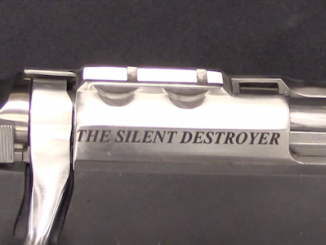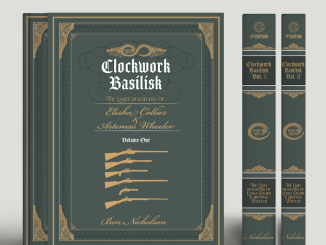When the United States entered World War One, there was no formal sniper school or training in place. However, the US Army had adopted a sniper optic for the M1903 Springfield rifle. It was the M1908 Warner & Swasey Musket Sight, a prismatic, 6x magnification scope. It was shortly updated to the M1913 configuration, and several thousand of each type were mounted to M1903 rifles, as well as M1909 Benet-Mercie light machine guns.
Theseoptics were not particularly good by modern standards, as they were heavy and suffered from fogging and condensation (they were not sealed designs). However, they were the equipment available to the Army at the time, and were put to use. This particular example is a 1913 pattern scope with a locking ring from the earlier 1908 model, mounted on a Springfield M1903 rifle.
Perhaps the most interesting elements of the Warner & Swasey are the data plates affixed all over it, providing ballistic data for the .30-06 ball cartridge which was in use during WWI.




Has any army in 1914 snipers school and/or formal training for them?
In 1914 I don’t believe that there was any formal training for snipers in 1914. It took years for any proper former training to be developed – let alone equipment to be issued on an official basis! In British service early sniping was completed with some very curious sighting methods and civilian Bisley-esque central sights.
It’s my understanding that sniping in WW1 was lead by the Germans, while the British and French had to play catch up in 1915-1916.
If I am not mistaken most snipers of WW1 were former hunters or similar,
for example Billy Sing (Australia):
https://en.wikipedia.org/wiki/Billy_Sing
was kangaroo hunter
Other examples:
Joseph Arthur Gregory (Canada) – hunter
Herman Davis (United States) – hunter
Hesketh Vernon Prichard (Great Britain) – hunter/adventurer/explorer
Archibald “Grey Owl” Belaney (Canada) – trapper
John Shiwak (Newfoundland) – hunter
Serbia had a school for dedicated marksmen that had was teaching ballistics and such, as well as fieldcraft, since 1908. Each company was supposed to have one such marksman under direct command of company commander.
One of those marksman managed to shot A-H sentry on other side of Sava river in the opening days of WW1 as a demonstration to French and Russian military envoys. IIRC distance was just short of 1000 meters. Rifle was 1899 model Serbian Mauser (no scope).
There were no scoped rifles until French re-equipment of Serbian army on Salonika front.
Ian, did I see a drift correction table on the front of the tube? If so, that’s really optimistic that a soldier would be able to understand, let alone apply it in a real-life situation.
The Type 97 sniper rifle seems user-friendly compared to this.
Yep, that’s what it is, and I agree.
Hesketh-Pritchard’s Sniping In France With Notes on the Scientific Training of Scouts, Observers, and Snipers is a remarkable read. Available on your local internets, including here: http://www.allworldwars.com/Sniping%20in%20France%20by%20Major%20Hesketh-Prichard.html
It’s not just the eye relief on those scopes, it’s the lateral displacement. The telescopic sights on those early rifles are positioned perfectly…for your left eye. If you have a decent cheek weld and are looking through the iron sights with your hopefully-dominant right eye (the British Army only had right-handed riflemen, whatever nature had made them), the telescopic sight is precisely where your left eye is. As Hesketh-Pritchard put it:
I’ve got one of these complete. Still looking for a 03 too unto it on. Every once in a while one pops up with filled holes but so far no luck. I currentlyount it on my 1909 benet mercie dummy but really want to get it on a 03.
Added the 03 with a repro mounting rail and being used in living history engagements. See it here in this video taking out a Hun in this WWI living history video at 2018 Camp Mabry Austin Event. https://www.youtube.com/watch?v=fGr-SwpJvQ0
Are you sure about the range correction table? For 10 yards difference at 500 a shift of the point of impact by 2.5 inches seems excessive. Try to work it out and you’ll find there is about a 10x error, this is a flat-trajectory high velocity round. 110 inches up or down for 3010 or 2990 yards? No, something’s wrong here even if the ranges are absurd.
Germany was ahead of everyone else here by using rationally the experienced hunters they had in large numbers. The Canadians, and perhaps Australians would be in a similar position if they selected their soldiers, the British probably went looking for Bisley champions, not quite the same sort of skill. Plenty of skilled shooters in the Scottish Highlands, experts at camouflage and stalking deer, but would they be using optical sights?. English gentlemen use shotguns and shoot grouse and pheasant, it’s a culture thing.
Many years ago I saw an M1903 with a tube type scope and no forward blade sight. I didn’t have the money for it. Was that a W W II type?
That was likely a World War Two sniper rifle. Before that, one could not make a realistically functioning rifle without iron sights.
Yes, since modern day tube scopes were not standard issue in WW1.
Would beat Galilean sights at the very least….
Was the arrangement / mounting of the scope on this rifle much different than that of the rifle that McBride used?
McBride complained about a good number of things, but I don’t recall him ever really complaining about his Ross rifle and the scope (same manufacturer of the one in the video) it used.
If I recall correctly, he thought the German snipers were good at closer ranges, but that the Canadians were much better at long range (400 yds+). That would imply that the Germans had been hunters and the Canadians had done competitive long range shooting. The great snipers had done both.
He really liked the ability to co-witness with the iron sights to make sure the scope was still in good alignment. Besides razor blades for shims, he used salt water to rust the parts together. Seems like he had a primitive flash-hider made for the rifle.
The story goes that when WWII, Korea, then Vietnam got started, the U.S. military figured out they needed snipers and fell back on McBride’s book to start the program.
These sniper rifles were dissembled in the 1920s. Almost everyone for sale today are reassembled from the surplus parts. I have seen many of the WS musket sights and everyone needed cleaning. A small drop of congealed oil or small flakes of the interior paint will make the sight unusable. One must find a person skilled in the arts of scope repair and cleaning in order to make their optic work. It is doubtful that any WW1 03 snipers are original.
“The story goes that when WWII, Korea, then Vietnam got started, the U.S. military figured out they needed snipers and fell back on McBride’s book to start the program.”
When I joined the Marines in 1962 Snipers were absolutely “outlawed” by the US military … at least officially. The first rifle I was tested with was an M-14 equipped with a scope and a “Star Barrel” plus some tweaking at Quantico. We were called “marksmen” or “designated marksmen” and we were just another warm body in the ranks as far as paper work was concerned. When deployed we were called “Head Hunters” and were “running ambushes” instead of sniping. We had a five-man team: Designated Shooter/Marksman, Spotter, Ammo Humper and two men who were assigned to protect us while we worked. We never went out with the rest of our unit in combat mode. Infield we often used the older Remington M-40s in .300 Winchester Mag. with Fecker or Unertl scopes. I later wound up with a Stoner A-10 and then a Stoner M-110. But you NEVER mentioned the word “Sniper” under any circumstance unless you wanted a Court Martial and an extended vacation at hard labor. But in reality everyone knew what we were and who we were. It was just a word game.
“It was just a word game.”
Sometimes formal restriction lead to peculiar situation, for example in 1930s United States tanks were considered to be infantry weapon, so when tanks were used by U.S.Cavalry they were officially named M1 Combat Car
https://en.wikipedia.org/wiki/M1_Combat_Car
The mounting rail and the rubber eyecup have replicas. A replica eyecups beats the remnants of hard rubber. I donated one of the replica rubber eyecups to the NRA museum, don’t know if they are using it, and it looks and fits great. It’s black, not white. They started putting carbon in rubber tires sometimes in the early to mid teens so I don’t know if maybe the WWI scopes were a mix.
The naval purchased 1909 Benet Mercies, I have read somewhere, were not issued with the scopes and I don’t think the Army used them on their Benet Mercies in the punitive expedition. The scope really dressed up the Benet for display though.
A lot more of the scope bodies seem to have survived compared to the adjustment mount, which is a shame,…somebody might be able to make a repro mount with the dials and all now that we have laser cutting/etching.
I do note that the scope that in the RIA auction does not have the scalloped out areas for the screws on the top of the mount. It is in the two thousands, fairly early production for the 1913 so maybe the scalloping was in later production, maybe wartime as the rifle serial puts this scope mated with a 1914 rifle, if I read the serial right.
We had a little rule of thumb for wind correction using 7.62 Nato ammunition. Take the range in hundreds of metres, square that figure and that’s the number of inches you have to aim into the wind, the standard figure 11 target was 18 inches wide so you could work it out from there. This is for a stiff breeze, enough to get the range flag waving but not flapping madly, and cutting straight across your line of fire. If the wind was coming in at 45º you halved the correction, ignoring whether it was blowing towards you or away from you. If it was a light breeze, just lifting the range flag, you halved the initial figure, and if it was a stronger wind, pulling the flag from the mast, you doubled it. Head or tail winds you just ignored. Worked fine, and even better with the LMG (Bren in 7.62 Nato) in single shot mode.
Another downside of the W & S sight is the most deleterious changer in the weight and balance of the ’03 Springfield. The added weight is considerable and produces a severe counterclockwise torque on the weapon. It is frustrating trying to pick out a target with the torque, dimness, small field of view, and exceedingly short eye relief. After shooting with it, one is almost better off with just disposing of it and using the irons. The Winchester A-5 scope was vastly superior, but obviated the use of stripper clips. I believe that only the Marine Corps fielded some ’03s with the Winchester scopes and possibly a very few Feckers in WW1. A friend of mine who was a Marine Scout/Sniper on Guadalcanal carried a NM ’03 with a Winchester A-5 scope. But for most all of his work he preferred the few M1941s and Johnson Automatic Rifles that were around.